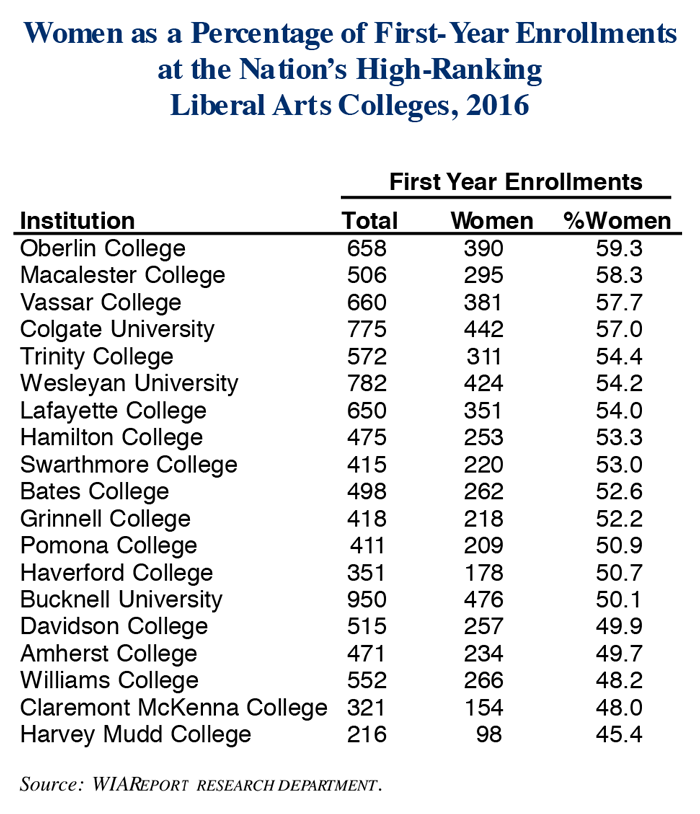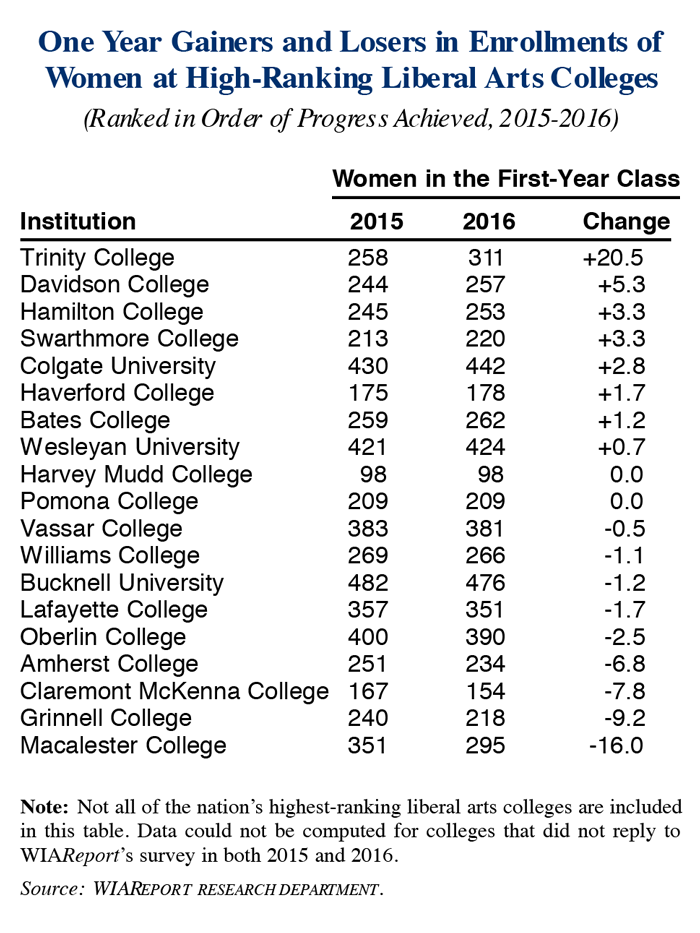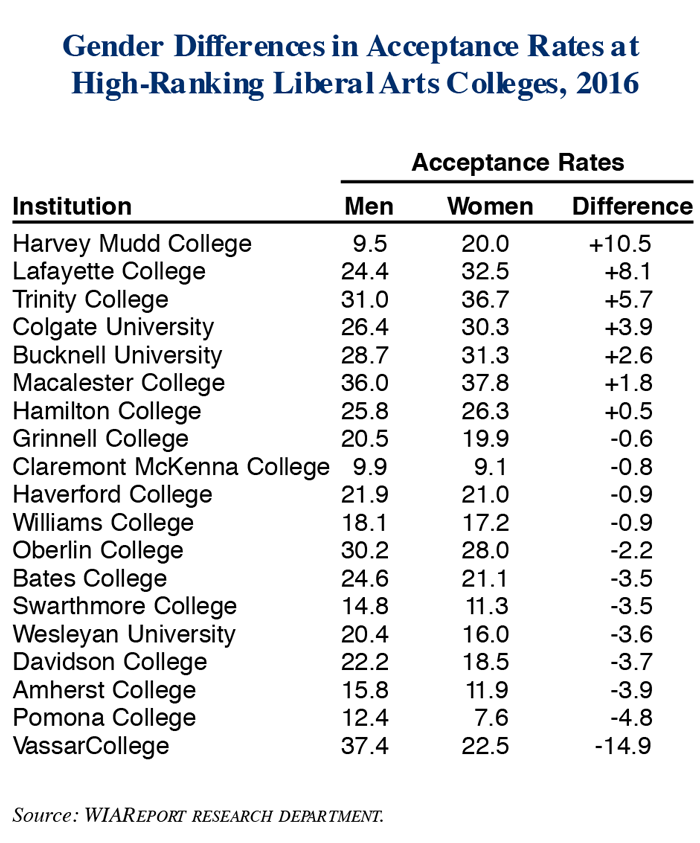First-Year Women Students at the Nation’s Leading Liberal Arts Colleges
Posted on Dec 27, 2016 | Comments 0
![]() For the sixth year in a row, WIAReport has surveyed the nation’s highest-ranking co-educational liberal arts colleges to determine the percentage of women in this year’s entering classes. This year, for the fifth time, we also report on gender differences in acceptance rates at these schools and whether women have made gains in enrollments at these colleges compared to where they were a year ago.
For the sixth year in a row, WIAReport has surveyed the nation’s highest-ranking co-educational liberal arts colleges to determine the percentage of women in this year’s entering classes. This year, for the fifth time, we also report on gender differences in acceptance rates at these schools and whether women have made gains in enrollments at these colleges compared to where they were a year ago.
We note here that several of the nation’s leading liberal arts colleges are educational institutions for women. These include Smith College, Bryn Mawr College, Wellesley College, Scripps College, and Mount Holyoke College. Because only women are admitted to on-campus undergraduate programs at these highly regarded colleges, they were not included in this survey which focuses on gender differences in enrollments and acceptance rates.
Of the 19 high-ranking liberal arts colleges that responded to our survey, women were a majority of the entering students at 14 schools while there were more men than women in the entering classes at only five liberal arts schools. A year ago when 20 high-ranking liberal arts colleges responded to our survey, women were a majority of the entering students at 14 schools.
There are wide variations in the percentage of women in the first-year classes at these highly rated liberal arts institutions. Five years ago, Oberlin College in Ohio had the highest percentage of women in its first-year class. Four years ago, Bucknell University in Lewisburg, Pennsylvania, had the highest percentage of women in its entering class. For the last three years in a row women made up the largest percentage of the entering class at Macalester College in St. Paul, Minnesota, among the liberal arts colleges that responded to our survey. This year, Macalester had the second highest percentage of women in its entering class. Women make up 58.3 percent of the entering students at Macalester this year. Two years ago, women were 63 percent of entering students.
This year, Oberlin College, once again, has the highest percentage of women in its entering class among the high-ranked liberals arts colleges. Women make up 59.3 percent of the first-year students at Oberlin.
Colgate University, Trinity College, and Vassar College all have entering classes that are at least 55 percent women.
At the other extreme, women make up only 45.4 percent of the entering students at Harvey Mudd College in Claremont, California. That is the lowest percentage of women at any of the nation’s leading liberal arts colleges in our survey. This prestigious school is heavily oriented toward STEM disciplines where women have traditionally been underrepresented.
Claremont McKenna College in California has the second lowest percentage of women in its entering class at 48.0 percent. The only other three high-ranking liberal arts colleges in our survey where men are a majority of the entering class are Davidson College in North Carolina, Williams College in Massachusetts, and Amherst College in Massachusetts.
Four years ago there were more leading liberal arts colleges that showed a drop in women first-year students than those that posted a gain. For the next three years the opposite was true. For the 19 schools for which we have data for each year, eight show an increase in women in their entering classes. Nine show a decline and two liberal arts college had the exact same number of women in their entering class as they did a year ago.
Trinity College in Hartford, Connecticut, led the group with a large 20.5 percent increase in the number of first-year women students. At Davidson College in North Carolina, the number of women in the entering class is up 5.3 percent from a year ago. First year enrollments of women were up at least 3 percent at Hamilton College in New York and Swarthmore College in Pennsylvania.
In contrast, the number of entering women students at Macalester College is down 16 percent from a year ago. Grinnell College in Iowa has 9.2 percent fewer women in its first-year class than was the case a year ago. At Claremont McKenna College and Amherst College, the number of women in the first-year class is down more than 6 percent.
It is well known that nationwide women outpace men in college enrollments, graduation rates, and degrees earned. Because of a large and growing gender gap in enrollments at many colleges and universities, it has become easier for men to gain admission to some colleges and universities. Now, just because men have a higher acceptance rate than women at a given institution does not necessarily mean that men have received an unfair admissions advantage. A particular college or university may simply have had an outstanding pool of male applicants in a given year.
We will simply present the data and let readers make their own conclusions. In most cases, differences in acceptance rates were small. Of the 19 highly rated liberal arts colleges that supplied data, we find that women were accepted at a higher rate than men at seven institutions. Men were accepted at a higher rate than women at 12 liberal arts colleges.
The greatest difference in favor of women was at Harvey Mudd College, which as stated is heavily focused on STEM disciplines. At this highly rated college, 20 percent of women were accepted for admission compared to only 9.5 percent of male applicants. Thus, there was a very large acceptance rate gap in favor of women of 10.5 percentage points. Three years ago, the gap in acceptance rates in favor of women at Harvey Mudd College was 19.2 percentage points
The next highest acceptance rate gap was at Lafayette College. There, women had an acceptance rate that was 8 percentage points higher than the acceptance rate for men. Lafayette, which did not accept women until 1971, has a large contingent of engineering students, a field where women are traditionally not well represented. At Trinity College, women were accepted at a rate more five percentage points higher than the rate for men. No other high-ranking liberal arts colleges had an admission advantage for women of greater than 4 percentage points.
Vassar College, which was once a women’s college, has an acceptance rate for men that is significantly higher than the rate for women. In 2016, Vassar accepted 37.4 percent of male applicants but only 22.5 percent of women applicants. This is, by a large margin, the largest acceptance rate gap in favor of men at the nation’s leading liberal arts colleges. Pomona College in California was the only other leading liberal arts college where men were accepted at a rate at least four percentage points higher than for women. Wesleyan University, Amherst College, Swarthmore College, Bates College, and Davidson College were the only other leading liberal arts colleges where the acceptance rate for men was more than 3 percentage points higher than the acceptance rate for women.
Filed Under: Featured











